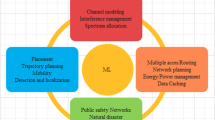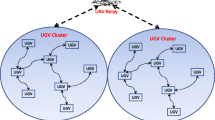Abstract
Data delivery in Cyber-Physical Battlefield Perception Systems(CPBPS) is a challenging task due to the ubiquity locations and the high mobility of node. Due to the special geographical circumstances, communication networks based on fixed infrastructure are unlikely to be established. This paper presents an air-ground coordination communication transmission network, which consists of Unmanned Aerial Vehicle (UAV) subnets and ground vehicle subnets. The UAVs exploit air-to-air (A2A) and air-to-ground (A2G) communication links to assist vehicle communications. However, overreliance on satellite positioning may cause military information to leak. Therefore, we proposed a K-Nearest Neighbor (KNN )combined with genetic algorithms and based on machine learning system (MLS) for data delivery for battlefield environment to realize the privacy protection and guarantee the security with better prediction. The proposed KNN machine learning system can estimate the movement and path of vehicles based on the mobile information obtained. Furthermore, in order to transmit data of UAVs more efficiently, the genetic algorithms (GA) is utilized to determine the relative location of UAVs. Simulation results verify the performance of proposed algorithm.











Similar content being viewed by others
References
Nan Z, Cheng F, Yu FR, Jie T, Chen Y, Guan G, Sari H (2018) Caching uav assisted secure transmission in hyper-dense networks based on interference alignment. IEEE Trans Commun PP(99):1–1
Cheng F, Zhang S, Zan L, Chen Y, Nan Z, Yu FR, Leung VCM (2018) Uav trajectory optimization for data offloading at the edge of multiple cells. IEEE Trans Veh Technol PP(99):1–1
Yang G, He S, Shi Z, Chen J (2017) Promoting cooperation by the social incentive mechanism in mobile crowdsensing. IEEE Commun Mag 55(3):86–92
Yang G, He S, Shi Z (2017) Leveraging crowdsourcing for efficient malicious users detection in large-scale social networks. IEEE Internet Things J 4(2):330–339
Arokiasami WA Designing a multi-agent framework for unmanned aerial/ground vehicles. In: National University of Singapore (Singapore)
Hajjam A (2016) A near-to-far learning framework for terrain characterization using an aerial / ground-vehicle team. In: National University of Singapore (Singapore), pp 1–6
Yi Z, Li H, Shi C, Ning L, Nan C (2018) A fuzzy-rule based data delivery scheme in vanets with intelligent speed prediction and relay selection. Wirel Commun Mob Comput 2018:1–15
Yoon S (2009) Novel approaches to cooperation schemes in mobile networks. In: State University of New York at Buffalo, pp 1–6
Matolak D, Sun R (2014) Air-ground channel measurements and modeling for uas. Transp Sci 29(11):30–35
Blasch E (2013) Enhanced air operations using jview for an air-ground fused situation awareness udop. In: 2013 IEEE/AIAA 32nd digital avionics systems conference, pp 57– 60
Zhang W, Xi X (2016) The innovation and development of internet of vehicles. China Communications 13 (5):122–127
Salahuddin MA, Al-Fuqaha A, Guizani M (2015) Software-defined networking for rsu clouds in support of the internet of vehicles. IEEE Internet Things J 2(2):133–144. Nove
Ji-Hui Z, Hui X, Ying Y (2008) Research and development of electric vehicle data collection and calibration platform based on gprs and internet. In: 2008 IEEE vehicle power and propulsion conference, pp 1–5
Djamel B, Nacira G-Z, Cherif T (2012) Forecasting approach in vanet based on vehicle collision alert. In: 2012 IEEE symposium on robotics and applications, pp 1–5
Liu C, Liu X, Huang H, Zhao L (2008) Short-term traffic flow prediction methods and the correlation analysis of vehicle speed and traffic flow. In: 2008 international conference on computational intelligence and security, pp 1–8
Zhou Y, Cheng N, Lu N, Xuemin Shen S (2015) Multi-uav-aided networks: Aerial-ground cooperative vehicular networking architecture. IEEE Veh Technol Mag 10(4):36–44
Xu J, Zeng Y, Zhang R (2017) Uav-enabled multiuser wireless power transfer: Trajectory design and energy optimization. In: 2017 23rd Asia-pacific conference on communications, pp 4133–4138
Zeng Y, Xu X, Zhang R (2018) Trajectory design for completion time minimization in uav-enabled multicasting. IEEE Trans Wirel Commun 17(4):2233–2246
Suarez B, Theunissen E (2015) Systematic specification of conflict geometries for comparison and evaluation of human-in-the-loop traffic avoidance functions. In: Proceedings of IEEE/AIAA 34th digital avionics systems conference, pp 5A2–1–5A2–13
Johansen TA, Perez T (2016) Unmanned aerial surveillance system for hazard collision avoidance in autonomous shipping. In: Proceedings of international conference on unmanned aircraft systems, pp 1056–1065
Schrijver A (1998) Theory of linear and integer programming. Wiley, New York
Sahai A, Hoven N, Tandra R (2004) Some fundamental limits on cognitive radio. In: Proceedings Allerton communications, control, and computing, pp 1662–1671
Deyu Z, Ju RS, Khattar MA, Haibo Z, Ning Z, Sherman SX (2016) Utility-optimal resource management and allocation algorithm for energy harvesting cognitive radio sensor networks. IEEE J Sel Areas Commun 34(12):3552–3565
Berman P, DasGupta B (2000) Multi-phase algorithms for throughput maximization for real-time scheduling. J Comb Optim 4(3):307–323
Folino G, Pizzuti C, Spezzano G (2001) Parallel hybrid method for sat that couples genetic algorithms and local search. IEEE Trans Evol Comput 5(4):323–334
Rashid MA, Khatib F, Hoque MT, Sattar A (2016) An enhanced genetic algorithm for ab initio protein structure prediction. IEEE Trans Evol Comput 20(4):627–644
Ahmed ZH (2015) An improved genetic algorithm using adaptive mutation operator for the quadratic assignment problem. In: Proceedings of international conference on telecommunications and signal processing, pp 1–5
Gottlieb J, Marchiori E, Rossi C (2002) Evolutionary algorithms for the satisfiability problem. Int Conference on Telecommunications and Signal Processing 10(1):35–50
Deyu Z, Ruyin S, Ju R, Yaoxue Z (2018) Delay-optimal proactive service framework for block-stream as a service, IEEE Wireless Communications Letters EarlyAccess, pp 1–1
Bajrami X, Dermaku A, Demaku N, Maloku S, Adem K, Kokaj A (2016) Genetic and fuzzy logic algorithms for robot path finding. In: Proceedings of mediterranean conference on embedded computing, pp 195–199
Abdul-Rahman O, Munetomo M, Akama K (2011) An improved binary-real coded genetic algorithm for real parameter optimization. In: Proceedings of 3rd World Congress on Nature and Biologically Inspired Computing, Salamanca, pp 149–156
Acknowledgments
This work was supported in part by Research Project for FY2017 of International Association of Maritime Universities, China Postdoctoral Science Foundation under Grant 2015T80238, Natural Science Foundation of China under Grant 61401057, Natural Science Foundation of Liaoning Province under Grant 201602083, Science and technology research program of Liaoning under Grant L2014213, Dalian science and technology project under Grant 2015A11GX018, Research Funds for the Central Universities 3132016007 and 01760325. Dalian high-level innovative talent project under Grant 2016RQ035.
Author information
Authors and Affiliations
Corresponding author
Additional information
Publisher’s note
Springer Nature remains neutral with regard to jurisdictional claims in published maps and institutional affiliations.
This article is part of the Topical Collection: Special Issue on Networked Cyber-Physical Systems
Guest Editors: Heng Zhang, Mohammed Chadli, Zhiguo Shi, Yanzheng Zhu, and Zhaojian Li
Rights and permissions
About this article
Cite this article
Zhao, J., Han, C., Cui, Z. et al. Cyber-physical battlefield perception systems based on machine learning technology for data delivery. Peer-to-Peer Netw. Appl. 12, 1785–1798 (2019). https://doi.org/10.1007/s12083-019-00769-5
Received:
Accepted:
Published:
Issue Date:
DOI: https://doi.org/10.1007/s12083-019-00769-5




